Manila through the eyes of Marius Black
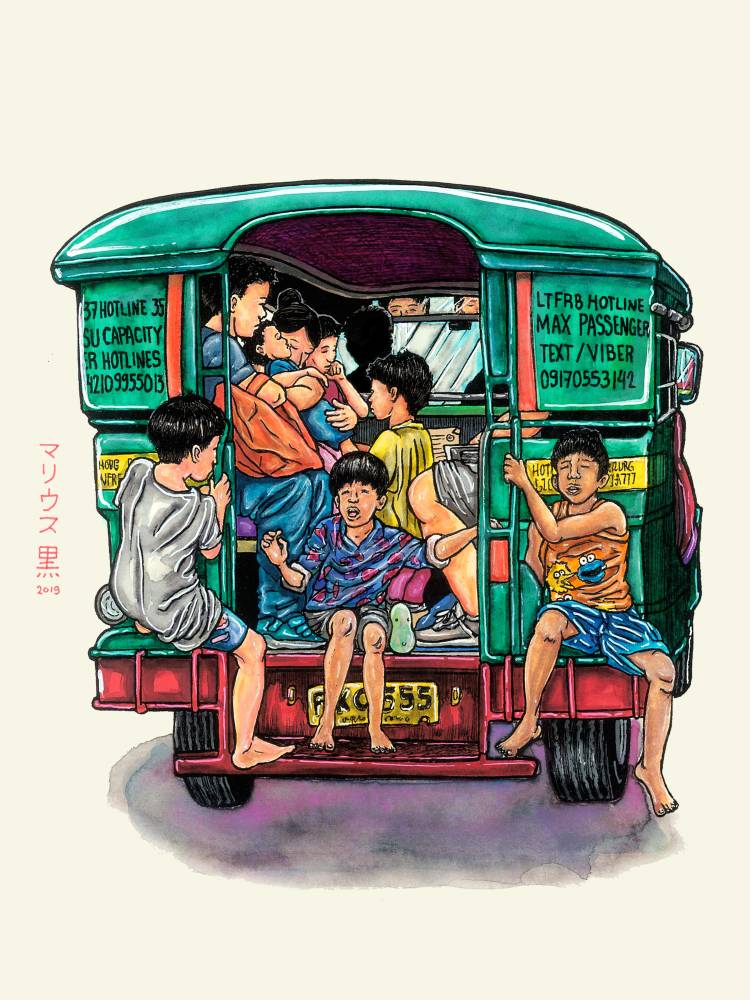
Marius Cornelius A. Funtilar, also known as Marius Black, has lived in Manila all his life.
The 37-year-old artist grew up near Blumentritt. Today, he lives just one LRT stop away—in Tayuman, with his wife and son.
It’s this same Manila that he captures in an art style he calls Manila ukiyo-e, inspired by the Japanese woodblock prints from the Edo period.
“I’ve always been interested in Japanese culture,” says Black. So much of Japan fascinates him—from their discipline, simplicity and minimalistic approach to the samurais, tea ceremonies, anime and of course, ukiyo-e art. “I decided to make our own ukiyo-e. Instead of samurai, I’ll depict modern people in the Philippines, like fishball vendors and taong grasa. I wanted to capture what I see every day in the streets of Manila that nobody really takes the time to look, let alone find beauty in.”
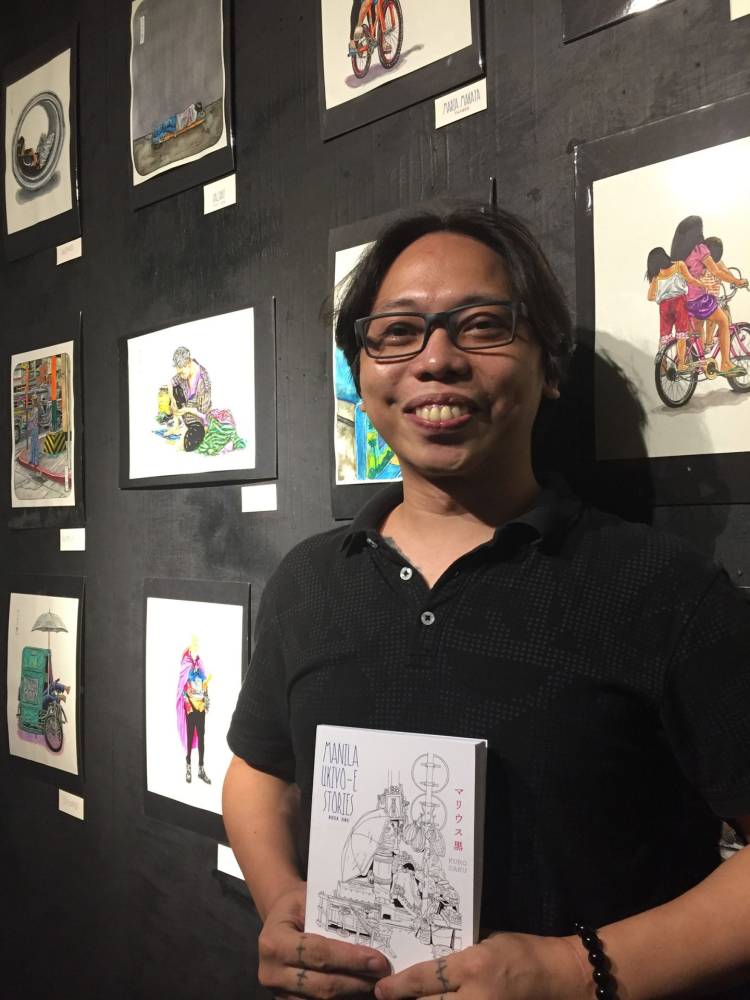
Like most kids of the ’90s, Black loved comic books, cartoons and video games. He grew up reading “X-Men,” watching “Teenage Mutant Ninja Turtles” and playing Rockman and Oddworld: Abe’s Oddysee.
“I found myself drawing comics inspired by the characters I’ve been playing, watching and reading about. I didn’t know what I was doing was art, I was just having fun and showing my comics to friends and classmates.”
Eventually, he would create his own characters and make a comic book about them. As he grew up, he would discover more serious comics like Gerry Alanguilan’s “Wasted” and delve into the art and life of Vincent Van Gogh. “I discovered the concept of being an artist and making art for a living.”
He tried to make art all the time—comics, at first—and then, wanting to “discover what art really meant,” he took up Fine Arts at the University of Santo Tomas where he majored in Painting. In school, he fell in love with painting. “I’ve been painting and drawing comics ever since.”
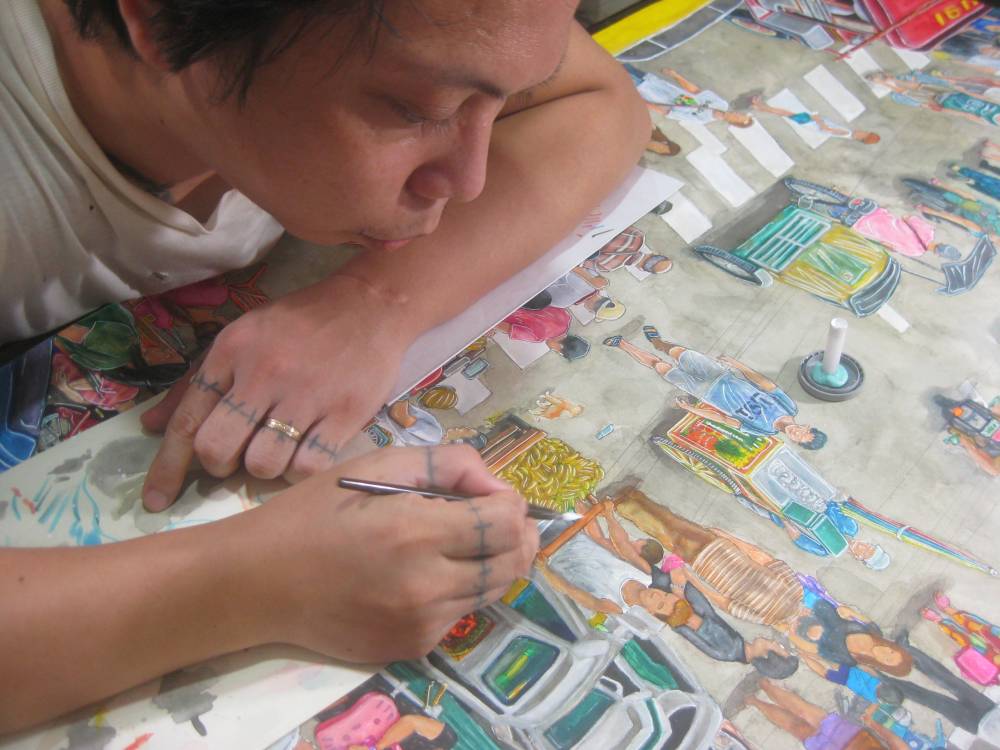
Art addict
Black, who calls himself an art addict, experimented with a lot of art styles including “very dark and surreal ones” until he finally landed on Manila ukiyo-e in 2017. “I wanted to paint something very traditional and simple. Easy to grasp but can hold a lot of meaning.”
The traditional painter and independent comic book artist believes his background in both art styles contribute to his creation of Manila ukiyo-e. “The art style is ukiyo-e and the colors are from ’90s ‘X-men’ comic books.”
He doesn’t use woodblocks. Instead, he draws the outline, scans it and uses a laser printer to print it on watercolor paper. He then paints it by hand, using watercolors, gouache, markers, pen and ink, even spray paint and liquid erasers.
He uses photography in his work too, shooting everything that strikes his eye for future use in comic books and his paintings. “I began to love photography in itself and tried to capture things I found interesting.”He shoots buildings, cars, people. “I was like a nature photographer taking photos of people living in their natural habitat—hardworking people sweating and making ends meet, people trying to steal a nap in the middle of the day.” He prefers to shoot people candidly because, if he asks them to pose, they become self-conscious. These real people then become immortalized in his art.
He captures the grit, the chaos and the strange beauty of life in Manila, one painting at a time.
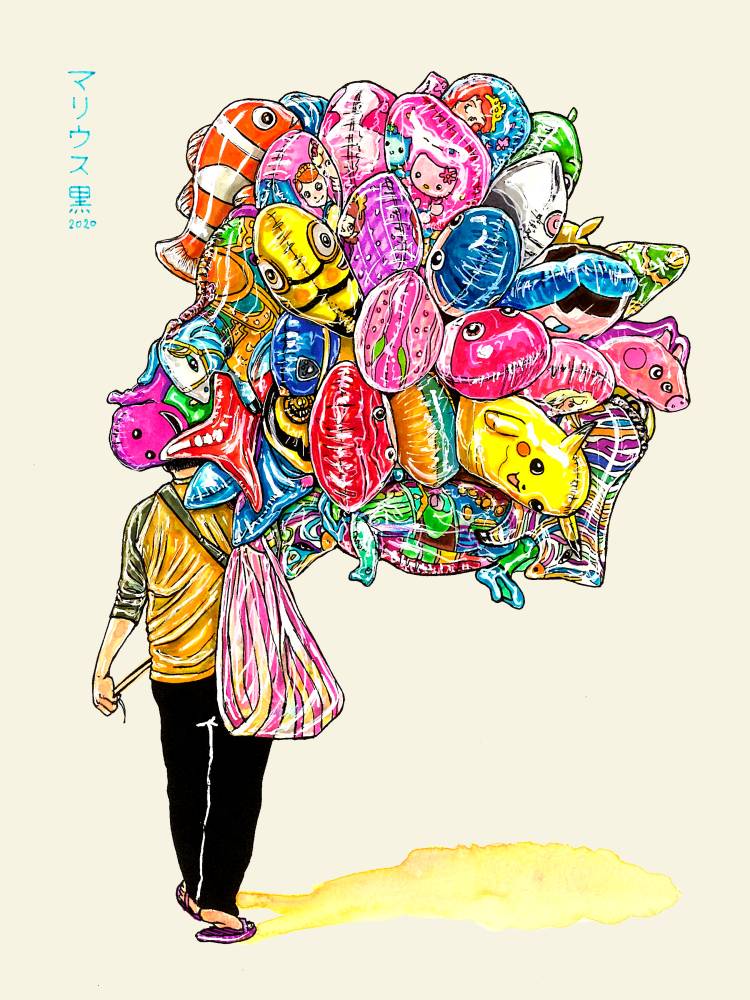
Black loves that his art can convey drama and happiness with just simple outlines and colors. “Beyond the style itself, for me, it’s more of the stories we can discover in each piece.”
Commuters hanging onto a jeepney, vendors selling all sorts of things (fishballs, balloons, newspapers, ice cream, taho), a kid doing her homework, a lady stocking the shelves of a convenience store, a woman waiting for the LRT, people sleeping everywhere—these are just some of the subjects of Manila ukiyo-e.
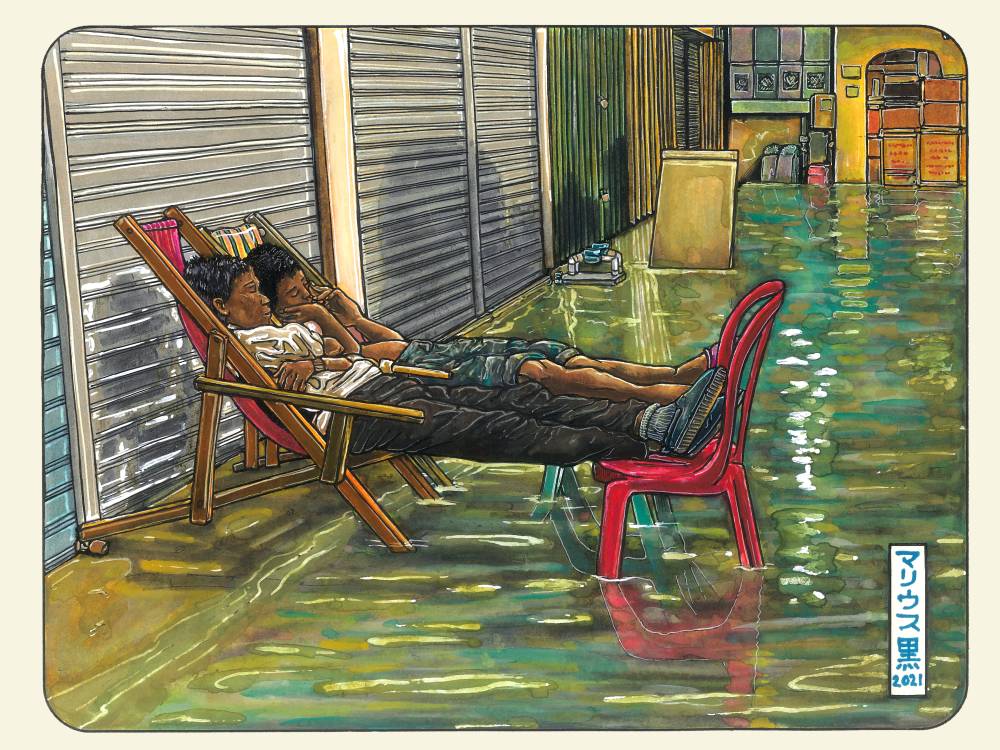
One of his favorite pieces is called “Tuyo” which depicts two men sleeping on seats on a sidewalk, managing to stay dry despite the flood surrounding them. Black still vividly remembers the night he stumbled upon them. He was on his way home from a drunken night of partying and was walking through the flood when he spotted them. He was so struck by the image that he immediately sobered up. “I was trying to throw my life away on drugs, girls and booze at the time when there are those struggling just to get a good night’s sleep. Seeing that changed me forever. I’m really glad I took a photo of it and was able to paint it years later for my Manila ukiyo-e series.”Another unforgettable project? The 100 ArtworX challenge he, his wife and their artist friends did last year. “We had to paint 100 ArtworX in one year to really force us not to slack off on making art as well as try to squeeze out creativity … I’ve found that we can find great ideas hiding underneath the pressure of a deadline.”
100 ArtworX led to his new series of cat paintings. “It’s one of my favorite series to do.”
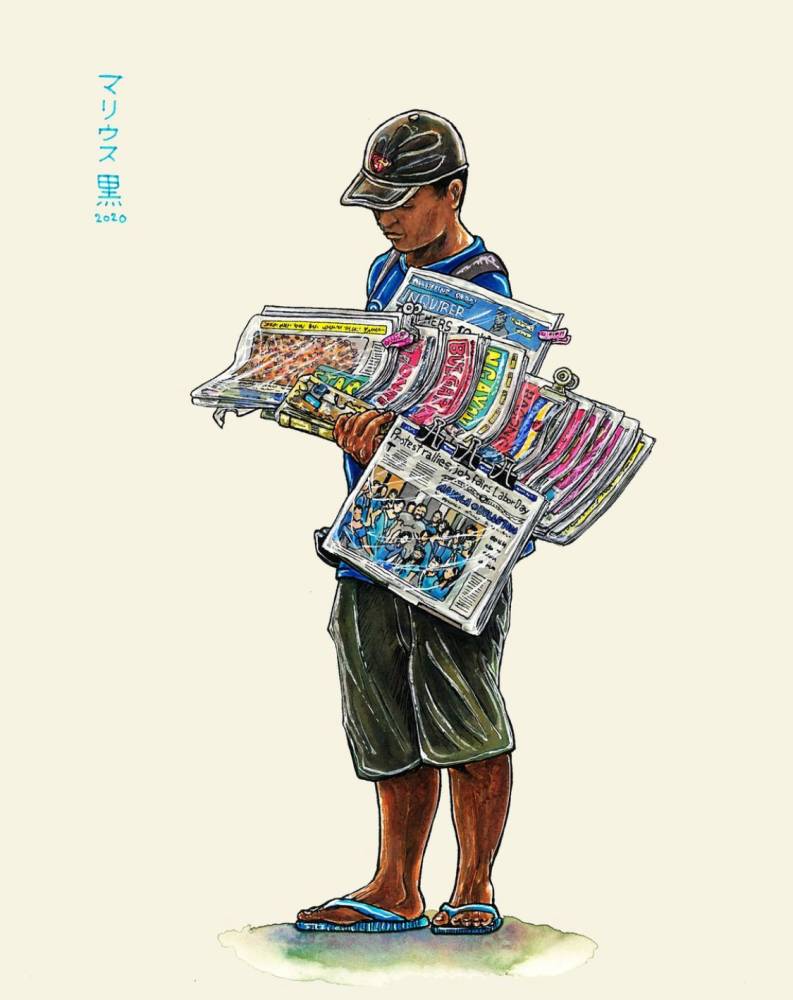
‘Blum’
He also really loves a huge painting he did for a solo exhibit at the BenCab Museum in 2021. The stunning 3- by 4-foot painting called “Blum” is a painting of Blumentritt based on a photo he took in 2018. It shows Blumentritt as seen from the LRT station, with multitudes of people going about their day, shopping, commuting, working, riding bikes, motorbikes, tricycles and jeeps. “It was really something to paint that many people,” says Black. But it was a challenge he relished because he was painting it at the height of the pandemic, when that usually busy street was suddenly empty. “I wanted to bring it back to the normal crowded Blumentritt in Manila, where people are mixed with the traffic like before.”
Blumentritt is a place that’s personal to Black. “It’s close to Tindalo Street where I grew up. And when I was a kid, my mom used to bring me [to Blumentritt] daily to help her carry vegetables, fish and meat we bought at the wet market, and I can remember admiring the people and their stalls, how organized and beautiful it looked when their tables were fully stocked in the morning. Blumentritt is a very special place for me.” But you don’t have to have a connection with Blumentritt to appreciate the beauty of “Blum.” A canvas print of the painting drew people to his booth at the Philippine Book Festival including one man who wanted to buy it so he could hang it in his living room.
There are many ways you can enjoy and own a piece of art by Black. You can buy the original hand-painted artwork, of course, but those who can’t afford the actual paintings have other options. There are poster prints and stickers of the cat series. The postcards are particularly popular. “People love them because they can send them to someone to remind them of their home here in the Philippines.” People also use the postcards as small artworks for decorating their spaces.
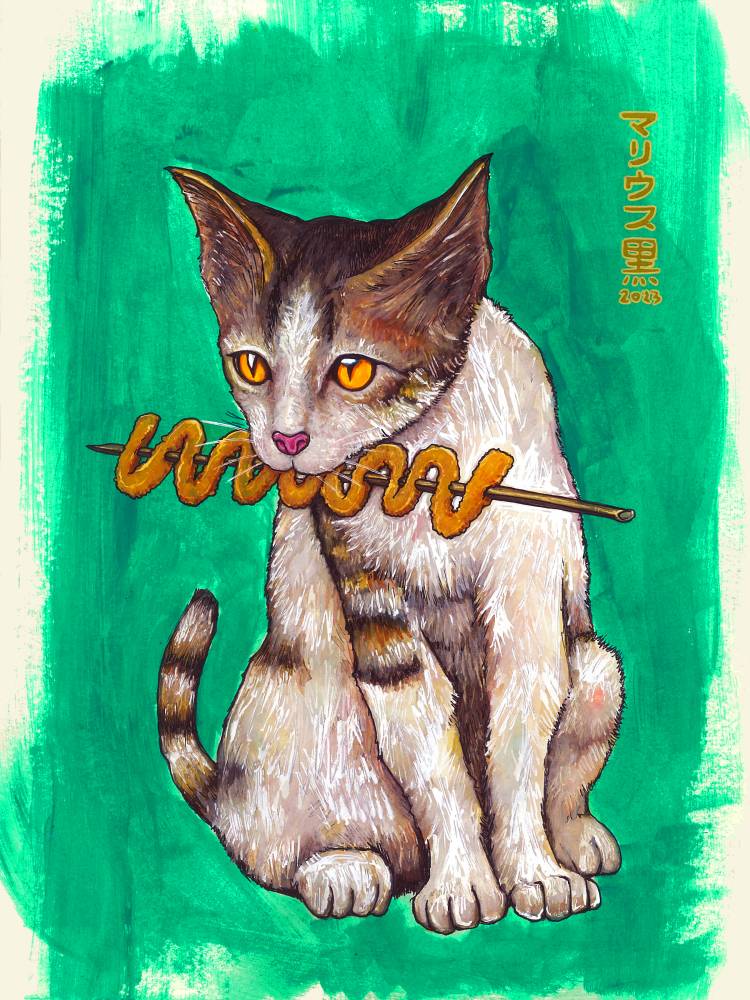
Black has also compiled his ukiyo-e into self-published art and poetry books as well. “I write poems about some of the artworks and I compile the paintings along with the poems … People really appreciate it, it’s one of our bestselling books, because it gives them some context of what I painted as well as my perspective on the piece, what I think their story is.”He finds inspiration in “just about anything.” “I’m easily inspired by people that I see, I find beauty in them that I can’t describe in words so I paint them and I have fun painting them and showing and sharing them with people who also find beauty in them.”
Black and his wife and fellow artist Guada Ramos Funtilar, who have formed the tandem art group Kuro Saku, are able to bring their art closer to people at their booth at events like Komiket and Toycon.
His favorite thing people say about his work? “Ang hirap pumili!” That’s something he often hears and rightfully so—after all, he’s created 347 Manila ukiyo-e pieces so far.
Somebody else told him something he won’t forget: “You find beauty in something shitty.”
Black said, “I found that there is a lot of beauty in Manila as long as your eyes are looking for beauty, even if it’s deemed by some as ugly.”
Find Marius Black on Instagram (@mariusblackarts) and Facebook (facebook.com/ManilaUkiyoE).





















